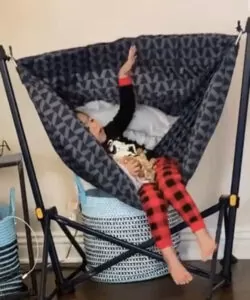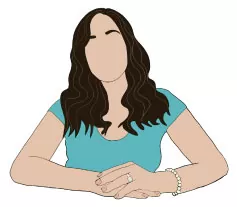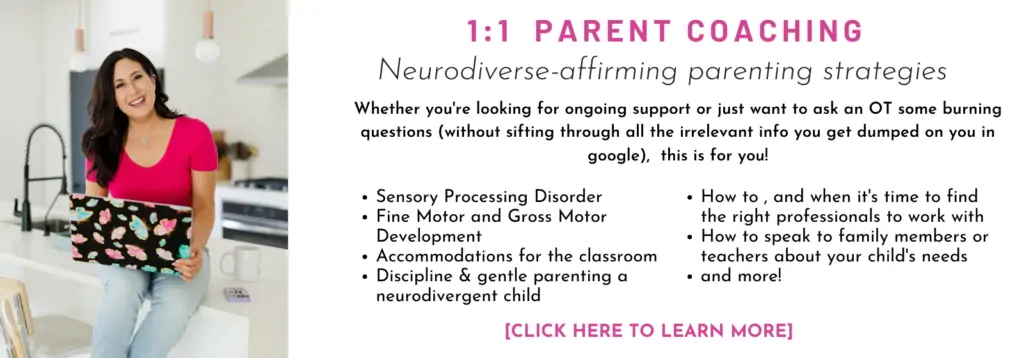Get your FREE sensory profiles cheat sheet >>click here<<
How to Support a Movement or Vestibular Seeker
We all know a kid who inherently NEEDs to move their body all day long. But have you ever noticed times when they appear to be even more dysregulated after getting more movement? This is very common for movement seekers.
Keep reading to learn more about this profile and you can best support movement seekers.
*PS- this post contains affiliate links, which means I make a small commission if you purchase using my link, but all my thoughts and reviews are authentic*
The Vestibular System
The vestibular system is housed in our inner ear, and is responsible for sending messages to our brain about the position and movement of our head. The vestibular system is activated anytime our head is tilted, upside-down, inverted, if we spin, if we run fast or run slow, when we’re on a swing or going down a slide.
We need vestibular activation and an efficient vestibular processing system in order to maintain an upright position, feel balanced, have a full sense of our body in space and focus.
Some people have low thresholds, in which they perceive vestibular activation at much higher rates (e.g. hypersensitive to movement). Others have high thresholds, which means that they need more intense, more frequent and longer duration of movement in order to register it and activate their vestibular system.
Enter: the movement seeker.
What Does a Movement Seeker Look Like?
A movement seeker (sometimes called movement craver) is someone who has a high threshold for vestibular input.
Some common signs of a movement seeker include:
- Enjoys fast movements (roller coasters, swings, skating)
- Enjoys spinning fast
- Decreased safety awareness or disregard for safety in order to get movement
- Constantly finding ways to move, even when seated
- Becomes more dysregulated even after a lot of movement
*This is one of the hardest concepts to grasp as it seems counterintuitive: a movement seeker who becomes more dysregulated with more input. It becomes a constant battle of trying to fight fire with fire and parents wonder: what can I do to help my movement seeker?
How to Support a Movement Seeker
When offering movement opportunities for your movement seeker, there are 2 things that are helpful to keep in mind in order to avoid further dysregulation:
1. Provide sensory activities that are goal directed
2. Provide sensory activities that have a clear start and stop:
|
Instead of: |
Make it goal directed and structured |
Have a clear start and stop |
|
Running around outside |
“How many acorns can you pick up?” |
“How many acorns can you pick up in 2 minutes? I’ll time you. Ready, GO” |
|
Spinning around in one direction |
Pick up laundry, spin around to throw it in the basket, then spin back around. |
After you collect 5 pairs of socks, stop and spin the other way to collect shirts. |
|
Running around aimlessly |
Play red light, green light, or freeze dance |
Stop during red light, or stop with music stopping |
|
Flipping head upside-down and hanging |
Hang off the edge of the couch to pick up a puzzle piece then sit up to add it to the puzzle |
A puzzle has a nice, clear end point. |
|
Rolling around on the ground |
Log roll or somersault across the floor to pick up a puzzle piece, lego, etc and roll back to put it in place. |
Count to 10 pieces, or until you finish the puzzle |
Click here to read more on my top tips for supporting any sensory seeker.
One other important tip that’s helpful for movement seekers to avoid further dysregulation is trying to incorporate as much heavy work (proprioception) input simultaneously. This is easy because there are several exercises or activities that provide both proprioceptive and vestibular activation.
For example, instead of pushing a child on a swing, allow them to swing themselves- which offers proprioceptive input.
Other vestibular + proprioceptive combined activities include: jumping on a trampoline, hanging from a trapeze or monkey bars, doing cartwheels or wheelbarrow walks.
You can also take a look at my sensory diet planner with a list of suggested activities and a chart to help you plan your week.

Find Ways to Incorporate Movement Opportunities During Seated or Focused Activities
Almost any table top activity can be done with an added gross motor/movement component to it, except for those that require sustained precision (such as writing long sentences, drawing pictures, or coloring- in which adding incremental movement breaks throughout the activity is helpful)
Toys or Activities with Multiple Pieces
Think: Puzzles, Mr. Potato Head, Legos, K’Nex, counting bears, beads. If you’re doing a craft or activity that has multiple cut out pieces to put together, this works too.
Spread out the pieces across the room on the floor and have the child do any of these movements to collect each piece:
- bear crawl (vestibular and proprioception)
- crab walk (proprioception)
- log roll (vestibular and proprioception and tactile)
- scooter board (vestibular)
- 2-foot hop (proprioception)
- crawl (proprioception)
- wheelbarrow walk (vestibular and proprioception *requires adult support)
Add obstacles in the way to jump over or duck under for added heavy work.
Have more time and want to encourage even more movement? Hide the pieces under pillows, in different rooms, and give the child different close to search for them around the house or in the clinic.

For puzzles, using letter tiles or other easy sorting activities, have the child lay on their tummy directly on the ground for some proprioceptive input, or lay over a yoga/peanut ball for added upper body strengthening.

Have a little one (ages 2-5) doing color sorting, shape sorting, or puzzles? Let them sit on a Sit-n-spin to sort the pieces.

Practicing Spelling Words, Math Facts or Sight Words
Rote memorization skills can be monotonous and hard for anyone, let alone our little ones who just need movement. Integrating movement will keep them engaged longer and help with their memorization.
- Lay out sight words on cards, draw equations/numbers on the ground with chalk and have the child jump to the answers.
- Tape up words/math facts/numbers (anything you’re trying to recall information for) to the wall just above their tippy-toe height and have them jump up to tag the right answer.
- Do you have one of those personal indoor trampolines? (If not, just have the child stand on the floor, or inside a hula hoop/circle made out of anything!) Add print outs of the spelling words/letters/numbers around the perimeter of the trampoline and have the child jump from the trampoline down to the answer.
- Have you seen this mind blowing hack for a DIY indoor stationary bike? This could be the answer to SO many of your questions and could definitely be used for things like practicing spelling words, math facts, and even while reading.
- Do one sit up/pushup/jumping jack or any exercise while spelling out a word or counting for a math fact.







One Response